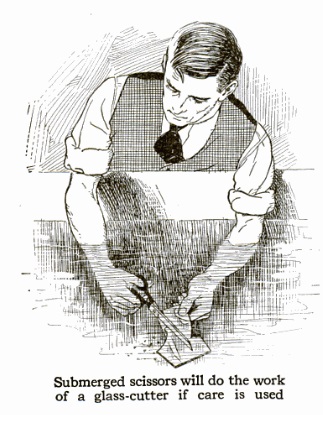 A hundred years ago this month, the May 1919 issue of Popular Science showed how to cut glass with a pair of scissors. Lo and behold, it is possible, as long as the glass is submerged under water.
A hundred years ago this month, the May 1919 issue of Popular Science showed how to cut glass with a pair of scissors. Lo and behold, it is possible, as long as the glass is submerged under water.
The article noted that it is often necessary to cut an odd-shaped piece of glass, such as to replace the broken glass on an electrical instrument. According to the magazine, “ordinary window-glass may be cut to almost any desired shape by holding it beneath the surface of a pan of water and cutting with house shears.”
A straight cut was not possible, but it was possible to “chew out” the piece. Of course, my first reaction was that if this was indeed possible, then there would be YouTube videos, and indeed there were, such as this one, which inexplicably tells you not to try it at home. I encourage you to try it at home, but the recommendation to use eye protection is a good one.
According to this website, an unnamed issue of Scientific American explains the phenomenon by saying that water causes glass to crack more easily when water enters the crack. The “silicon-oxygen bond at the crack and an oxygen-hydrogen bond in the water are cleaved, creating two hydroxyl groups attached to silicon. As a result, the length of the crack grows by the size of one bond rupture. The water reaction reduces the energy necessary to break the silicon-oxygen bonds, thus the crack grows faster.”
How well does it work? That question would be suitable for some young scientist to explore as part of a winning science fair project.
